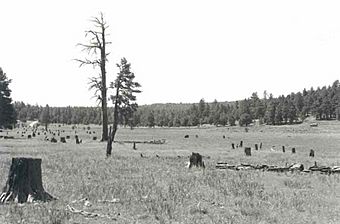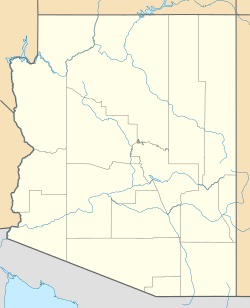Barney Flat Historic Railroad Logging Landscape facts for kids
Quick facts for kids |
|
|
Barney Flat Historic Railroad Logging Landscape
|
|

Stump field in Barney Flat. High stumps like these are evidence of historic logging practices. It was too difficult for loggers to use a hand cross-saw at the base of trees.
|
|
| Nearest city | Williams, Arizona |
|---|---|
| Built | 1899 |
| MPS | Logging Railroad Resources of the Coconino and Kaibab National Forests MPS |
| NRHP reference No. | 95000155 |
| Added to NRHP | February 24, 1995 |
The Barney Flat Historic Railroad Logging Landscape is a special place in the Kaibab National Forest in Arizona. It shows us how trees were harvested a long time ago, in the early 1900s. This area is famous because it's the only "stump field" listed on the US National Register of Historic Places. A stump field is a place where many tree stumps are still visible from old logging.
Barney Flat is located near Williams, Arizona, along the Perkinsville Road. It was added to the National Register of Historic Places on February 24, 1995. This means it's an important historical site that needs to be protected.
Contents
How Trees Were Logged by Railroads (1897–1936)
From 1897 to 1936, a company called Saginaw and Manistee used special temporary railroads to cut down many ponderosa pine trees. This was done on the South Kaibab Plateau. They used a method called clearcutting, which means cutting down almost all the trees in an area.
Moving Timber by Rail
At first, the company worked near Williams, Arizona. When they ran out of trees there in 1928, they moved north. They started logging near Grand Canyon National Park. To get the cut timber out of the forest, loggers would lay down wooden cross ties and then metal rails.
What Remains Today
The metal rails were often reused until they wore out. Then, they were sold for scrap metal. Because of this, you won't see many old rails today. However, the wooden cross ties often remain. These old ties are important clues that help us understand how logging was done in the past.
The Barney Flat Stump Field
Many experts believe that forests in the past had fewer trees per acre. They thought there were about 20 to 40 ponderosa pine trees in an acre. However, a detailed study of the Barney Flat Stump Field found something different.
Counting the Stumps
Archaeologists carefully mapped a 40-acre area at Barney Flat. They counted about 300 tree stumps in that space. This means there were less than 10 trees per acre. This discovery helps us learn more about how dense the forests were before logging began.
Discovering Old Railroad Grades
Archaeologists from the Kaibab National Forest have been busy mapping. They have found and mapped over 100 miles of old logging railroad grades. A railroad grade is the leveled path where train tracks used to be.
Learning from the Grades
These maps are very helpful. They show us exactly where and when the forests were logged. By looking at the condition of these old railroad grades, archaeologists can decide if they are important enough to be added to the National Register of Historic Places. This helps protect these historical sites for future generations.
Images for kids




